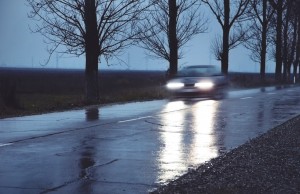Trust My Garage issues timely warning before clocks go back
Sunday 27 October officially marks the end of British Summer Time, and as the clocks go back drivers should brace themselves for a very dangerous period on the country’s roads. Recent research from insurance company Zurich found that there is an average increase of 11% in the number of car insurance claims made following the clock change. In this period in 2011, this accounted for 1,786 road casualties nationally, according to the Institute of Advanced Motorists. The message from Trust My Garage is clear – motorists need to see and be seen.
“As it gets darker much earlier, motorists need to make sure that they remain safe on the roads. October is a typical time for road accidents which can often be avoided by taking extra care on the road and by motorists carrying out extra checks on their vehicles, especially their lights,” warns Terry Gibson of Trust My Garage.
A recent survey by Trust My Garage found that 84% of motorists are failing to carry out basic checks on their vehicle, something which becomes increasingly more important at this time of year. Motorists who get used to driving their regular routes in broad daylight can find it hard to adjust to suddenly doing the same journey at the same time, but in the dark, often forgetting to switch on their headlights to make them more visible. Couple this with the fact that autumnal weather is often wet and windy, and the risk of having an accident on the road is greater than at any other time of year. The key to staying safe is preparation, especially when visibility is poorer.
Terry Gibson continued: “Drivers should ensure that their windows and lights are clean at all times to enable them to see what is happening around them. A good rule of thumb is to turn on dipped headlights whenever the windscreen wipers are on.Being seen is as important as seeing. Remember it is an offence to let your reservoir run out for your windscreen washers, so make sure this is always topped up and have your tyres at the correct pressure so your stopping distance is not increased. Regular servicing can help make sure your car is fit for darker and wetter conditions.”
As well as ensuring that a car is fit for purpose, motorists can also improve their own driving practice and awareness to make sure that they remain safe when driving in dark and often dangerous conditions. Taking regular breaks on long journeys and allowing more time to stop behind a car in front can all enhance safety while driving.
-
Categories
- Abarth
- Alfa Romeo
- Aston Martin
- Audi
- Bentley
- BMW
- Caterham
- Chevrolet
- Chrysler
- Citroen
- Dacia
- DS
- Ferrari
- Fiat
- Ford
- Great Wall
- Honda
- Hyundai
- Infiniti
- Isuzu
- Jaguar
- Jeep
- Kia
- Land Rover
- Lexus
- Lotus
- Maserati
- Mazda
- McLaren
- Mercedes
- MG
- Mini
- Miscellaneous Articles
- Mitsubishi
- Morgan
- Motability
- Nissan
- Peugeot
- Porsche
- Renault
- Rolls-Royce
- Saab
- Seat
- Skoda
- Subaru
- Suzuki
- Tesla
- Toyota
- Vauxhall
- Volvo
- VW
- Zenos
-
Articles
- April 2025
- February 2025
- January 2025
- September 2024
- July 2024
- March 2024
- January 2024
- December 2023
- September 2023
- August 2023
- May 2023
- January 2023
- October 2022
- July 2022
- May 2022
- April 2022
- February 2022
- December 2021
- November 2021
- October 2021
- September 2021
- August 2021
- July 2021
- June 2021
- May 2021
- April 2021
- March 2021
- February 2021
- January 2021
- December 2020
- November 2020
- October 2020
- September 2020
- August 2020
- July 2020
- June 2020
- May 2020
- April 2020
- March 2020
- February 2020
- October 2019
- September 2019
- August 2019
- July 2019
- June 2019
- April 2019
- March 2019
- February 2019
- January 2019
- October 2018
- August 2018
- July 2018
- June 2018
- April 2018
- March 2018
- December 2017
- August 2017
- July 2017
- June 2017
- May 2017
- March 2017
- February 2017
- January 2017
- December 2016
- November 2016
- October 2016
- September 2016
- August 2016
- July 2016
- May 2016
- April 2016
- March 2016
- February 2016
- January 2016
- December 2015
- November 2015
- October 2015
- September 2015
- August 2015
- July 2015
- June 2015
- May 2015
- April 2015
- March 2015
- February 2015
- January 2015
- December 2014
- November 2014
- October 2014
- September 2014
- August 2014
- July 2014
- June 2014
- May 2014
- April 2014
- February 2014
- January 2014
- December 2013
- November 2013
- October 2013
- September 2013
- August 2013
- July 2013
- June 2013
- May 2013
- April 2013
- March 2013
- February 2013
- January 2013
- December 2012
- November 2012
- October 2012
- September 2012
- August 2012
- July 2012
- June 2012
- May 2012
- April 2012
- March 2012
- February 2012
- January 2012
- December 2011
- November 2011
- October 2011
- September 2011
- August 2011
-
Meta




